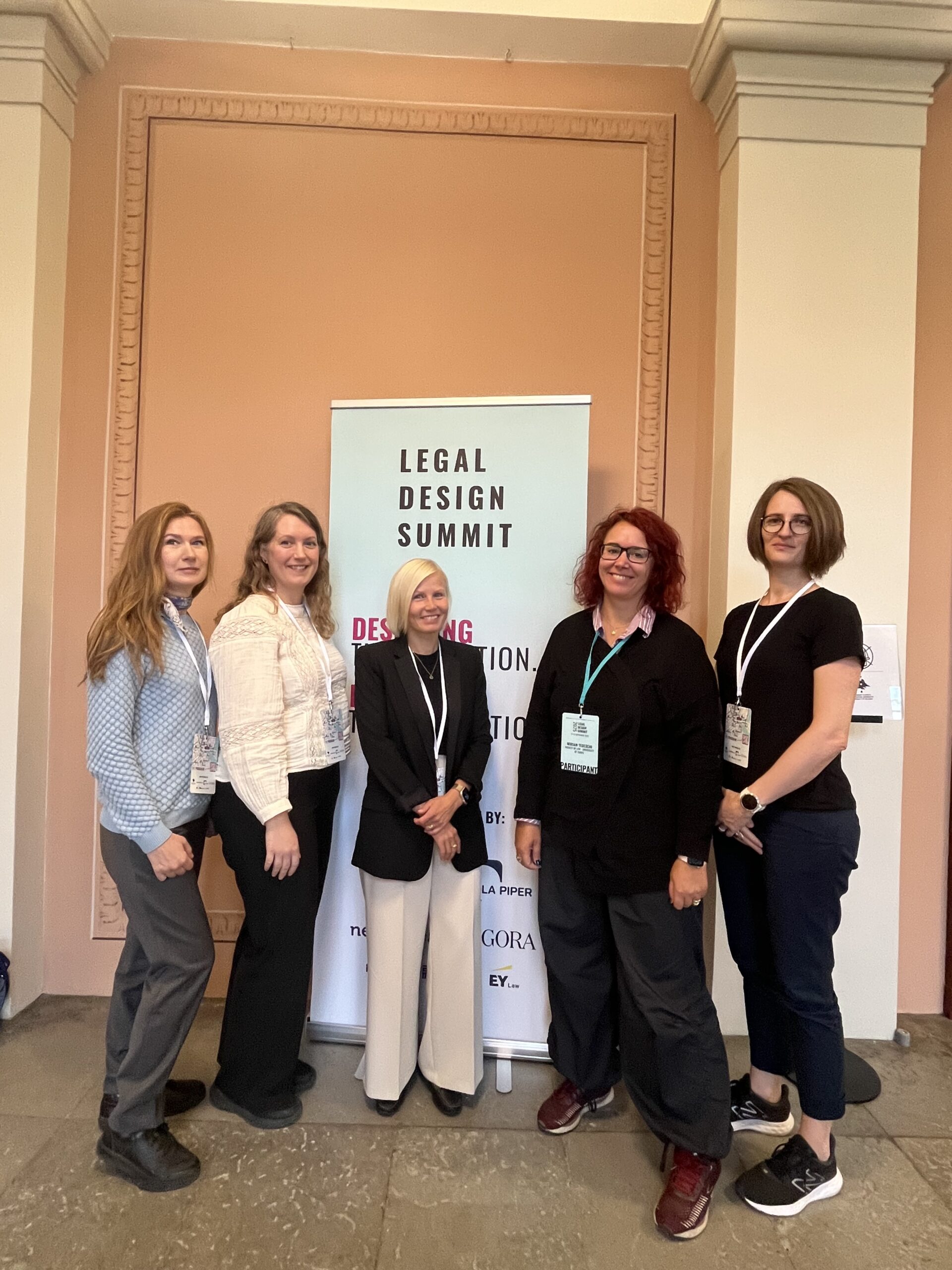The Legal Design Summit 2025 – Food for thought for research and teaching at the Faculty of Law
In September 2025, a group of Faculty of Law researchers and teachers headed to Helsinki to attend the Legal Design Summit 2025. This biannual event gathers a multidisciplinary audience of researchers and practitioners from all over the world around topics related to law and design.
The Summit covers ‘Legal Design’ from various perspectives, including art and visualization (e.g., using comics to make law understandable), technology (e.g., using multiple sources of data and digital twins in forensics), and language and semantics in contracts and legislation, including the simplification thereof. The conference also appreciates storytelling, whether that is about professional journeys of transforming from lawyer into designer, about frustration with how law firms operate or how contracts are written, or about more personal accounts of how design has changed lives.
This summit’s focus areas included Artificial Intelligence and Sustainability (and their integration), which are topical themes also in the research and teaching at the Faculty of Law. This text summarizes the talks and stories that made the strongest impression on the group of UTU participants.
Sustainability in contracts
In their presentation ‘Can contracts save the world?’, Anne Ketola and UTU Faculty of Law alumna Anna Hurmerinta-Haanpää (both representing the multidisciplinary project JARGONFREE) explored the role of contracts in shaping sustainability within business practices. Contracts in global supply chains are meant to be tools of clarity and accountability, and yet, when it comes to sustainability and human rights requirements, they frequently become entangled in vague, technical language. Such convoluted language makes it difficult for stakeholders to understand, monitor, and enforce sustainability commitments. The resulting lack of clarity not only undermines but actively hinders the very goals these contracts aim to achieve – fairness, transparency, and accountability – leading to human rights violations and adverse environmental impacts. To address this challenge, Ketola and Hurmerinta-Haanpää seek to re-imagine how sustainability is communicated in contracts. By replacing sustainabilitese with plain, actionable language and by incorporating legal design tools (e.g., layered design, comic contracts), they aim to make rights and responsibilities accessible to all parties in the supply chain, especially the most vulnerable ones.
Legal design in legislative language
Continuing on the subject of language, Eeva Attila and Saija Suominen (Senior Ministerial Adviser and Senior Specialist, respectively, working on legal revision at the Finnish Ministry of Justice) delivered a talk titled ‘Law Drafting Meets Legal Design’ in which they explored how legal design principles are applied in legislative drafting. The speakers emphasised the importance of using language that is ‘clear, easy to understand and to the point’, as prescribed in Section 9 of the Administrative Procedure Act. They shared practical insights into how this clarity is achieved through meticulous revisions that go beyond linguistic accuracy to address precision, consistency and overall readability. One illustrative example was the ‘3-3-3 Rule’, which recommends limiting each section to no more than three subsections, each subsection to no more than three sentences, and each sentence to no more than three clauses. While this rule may not always be feasible, it serves as a valuable reminder for all legal drafting: keep it clear and concise!
Accessible law in a global perspective
Legal design emphasises that people are at the centre; law and contracts are made for the user and should thus take into account their cultural context, background, capabilities, and vulnerabilities. When discussing digitalisation, AI and making law more usable and accessible, it should therefore not be ignored that individuals and states are at different points of the maturity curve, with some lagging behind in digitalisation, or lacking the networks and structures needed to push more user-centred or accessible law and contracting through legal design. In fact, some of the Summit speakers, including Sophie Ranaivoharisoa, argued that remnants of Colonialism are still present in some legal systems, and the struggle is then to make law accessible in the language of the people. When advocating for systemic change, one should remember that regional differences exist and make sure not to leave anyone behind. Digitalization and AI are undeniably pivotal tools in legal design, but they are still only means to an end of creating accessible law and contracts for the users. From the global perspective, there is still a need for low-tech solutions and inclusive legal design, as exemplified by information brochures used to enhance women´s access to justice in Tunisia (as presented by Dorra Harrar).
Legal design in legal education
Should a law school student approach law from a designer’s perspective? Ilona van de Kooi-van Opdorp (Researcher at the Convergence Center for Law, Design & AI (The Delft University of Technology & Erasmus School of Law) and Kim Raad (Senior information designer at Stibbe) answer in a definitive “Yes”. They believe the designer possesses the skill to architect the subject by bringing pieces together from different spaces. The multi-dimensional view is similar to a multi-disciplinary perspective. Ilona and Kim outline their vision of the legal design method as a step-by-step process of continuous communication and reflection, combined with a sensitive attitude and empathy. A first step to solving a complex legal challenge is to identify, gather, and define the needs of those you are trying to help to create a foundation from which you can overcome your own limitations in understanding the situation. Through constant cooperation with the target group, testing ideas, and receiving feedback, students are enabled to take the last step: finalizing a legal design solution that creatively changes the situation. Therefore, teaching design skills to law-school students can be a helpful tool to train not only professionals but also lifelong learners, especially in the era of artificial intelligence. As another speaker at the Summit, Christian Djeffal (Tenured Professor, Technical University of Munich (TUM)) highlights, a designer perspective helps to deal with AI tools only as tools to find more pieces to connect, rather than to create a solution. The mindset of a designer, who guides the process of creation, can be viewed as a mindset akin to that of a knowledge manager.
More-than-human design
Nina Toivonen’s intervention, titled ‘What if Birds Could Tell Us What is Right? A Curious Visit to the World of Designing with the More-than-human’, was the only one non-human-centred. Not in the sense that humans would be out of the picture in legal design, but rather, that they would need to recognise that they are part of a larger, complex ecosystem, where there are different forms of intelligence and agencies (e.g. plants and animals). These other intelligences form and follow their own norms. For example, we can observe how birds form shapes in the sky according to their own codes.
Ecological (non-human) crises are currently driving the futures of human laws and norms. To be able to face such challenges ahead, humans need to start listening to the voices of these multiple intelligences and understanding their agencies and codes of behaviour. The world is not human-centred, and humans should start including other types of agencies within their own operations to implement more just laws, not only for themselves, but for the whole environment. Nature is usually understood as passive, mute, and unintelligent. More-than-human design challenges this view.
What was missing?
A few words could also be dedicated to what we felt was missing at the Summit. While the programme was very diverse, one should not expect to leave the conference with a toolbox of methods and approaches that can be directly implemented in research and teaching. Instead, the use cases presented are often (but not always!) success stories of implementation processes or legal design outputs, and the format is closer to a TEDtalk than a typical academic conference presentation. While the talks are inspiring and well-rehearsed, the conference is (still) seemingly focused on making the case for legal design and winning over the mainstream lawyer/designer/contract manager by changing the mindset – which might be justified, since the change is still not happening at a broad scale, and the few companies that have used these types of tools and approaches seem reluctant to showcase their legal design.
Is there a future for legal design?
While digitalisation and AI can be useful in designing better law, a paradox was also put forward. Antti Innanen, who was an early adopter of legal design, expressed his worries about the future for design in general and legal design in particular, and whether it will become obsolete due to AI. What is the role of AI and technology in the future law profession? How is AI changing the legal profession, legal education, and how students enter the legal profession? Can legal design be a way to keep up with change? The conclusion, expressed by Innanen as well as other speakers, was that ‘we need to make AI output human-centric’, or, in other words, bring (or design) the human (in)to AI technology, because AI is only powerful if it empowers the people who build justice.
The Legal Design Summit is a non-profit legal design event, organized biannually in Helsinki since 2017. The University of Turku was one of the collaborators in the 2025 edition of the conference.
This text was written by
Isabell Storsjö (Coordinating author; Affiliated Researcher, Faculty of Law, University of Turku, and Senior Researcher, Finnish Environment Institute) holds degrees in both Law and Supply Chain Management. Her research covers multiple topics, including sustainability and resilience in procurement and supply management, and transformation and value chain governance.
Anna Krizsán (University Lecturer, Centre for Language and Communication Studies, University of Turku) is a linguist and educator specialising in Legal English and English for Academic Purposes. At the Faculty of Law, she is responsible for designing and teaching advanced courses of Legal English for Master’s degree students.
Rosanna Laurikainen-Klami (Doctoral Researcher, Faculty of Law, University of Turku, Lawyer, Senate Properties) is a contract lawyer. She researches complex, multi-party contract models, and at the Senate Properties, she is responsible for the legal issues related to the organization´s construction contracts and construction process.
Liudmila Sivetc (Faculty of Law, University of Turku, research project Dynamics of Digital Rights in Europe, funded by the Research Council of Finland grant (no 362853)) is a postdoctoral researcher who focuses on freedom of expression online and platform regulation by means of Internet infrastructure.
Miriam Tedeschi (Academy Research Fellow, Faculty of Law, University of Turku) is a legal geographer and ethnographer. She has recently concluded her Research Council of Finland (RCF) project ‘Justice in Digital Spaces’ (JuDiCe) (2022-2025), and started the new RCF project ‘Agency in everyday Datafication’ (AgenDa) (2025-2029). Tedeschi has multiple years of experience in carrying out ethnographic work and using design-related methods in a variety of spatio-techno-legal contexts.
Related Works:
Kaave, P., & Storsjö, I. (2025). Fostering security of supply in contract-based preparedness in the public sector through the proactive contracting and legal design approaches. International Journal of Commerce and Contracting, 9(1-2), pp. 35-63. https://doi.org/10.1177/29768829251325810.
Kaave, P., Storsjö, I. & Heikkinen, P. (2025). Access to justice in public procurement: improving judicial review through lean thinking, proactive law and legal design. TalTech Journal of European Studies, 15(1), pp. 155-178. https://doi.org/10.2478/bjes-2025-0009.
Storsjö, I., & Kaave, P. (2025). Promoting Sustainability in Supply Management Through Proactive Contracting and Legal Design. International Journal of Commerce and Contracting. https://doi.org/10.1177/29768829251369371.
Tedeschi, M., Aalto, J., & Verdu Sanmartin, A. (2024). Posthumanism, challenging the legal truth, and spatial (in)justice: pedagogical experiences reconnecting law to matter. The Law Teacher, 58(3), pp. 294–309. https://doi.org/10.1080/03069400.2024.2378625.
Tedeschi, M., and Rochielle Sievert, J. (2024) Spatial Justice in Design Research: A Transdisciplinary Discourse, in Gray, C., Ciliotta Chehade, E., Hekkert, P., Forlano, L., Ciuccarelli, P., Lloyd, P. (eds.), DRS2024: Boston, 23–28 June, Boston, USA. https://doi.org/10.21606/drs.2024.116.
Further resources:
Legal design tools:
The JARGONFREE project:
Finnish legislative drafting process:
Administrative Procedure Act (unofficial English translation):
Examples of current efforts to actively listen to other more-than-human entities:







